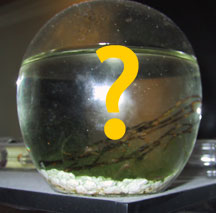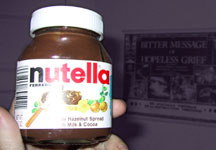Dedicated to preserving the long lost art of body modification in housepets. |
|
|
|
|
|
|
Dedicated to preserving the long lost art of body modification in housepets. |
|
|
|
|
|
|
Instructions submitted by a correspondent,
Warning, we have not tried this technique and cannot guarantee its efficacy.
We cannot be held responsible for any results achieved by hobbyists.

Dear Dr. Wong Chang,
First of all, let me express my most sincere appreciation and congratulations for your bonsaikitten.com site. You truly managed to express a poetic balance of ancient tradition, modern art, life and science. I was deeply touched by it.
Very humbly, may I submit to your attention a variation of your techniques which I developed for my niece Celeste, who is a first-grader and needed something for a school project about how to best care for newborn cats and dogs.
Since you cannot trust children to regularly feed their pets, I concluded that Celeste needed a self-contained unit. Also, she would have to pack it in her schoolbag, store it in the locker, etc., so even the appropriate supply of fresh air could become an issue.
An important piece of inspiration came to me when I saw one of those sealed spheres (EcoSpheres, or BioSpheres, they call them, I think) in a shop. Have you ever seen one of these? They are completely sealed microcosms harboring water, shrimp, plants, algae and bacteria in a symbiotic environment. You just put them on a shelf and forget about them. They can last years with no maintenance. For Celeste's school project we needed something like this. Here is a quote from a brochure: "Our ecosystems demonstrate in a most simplistic way the interdependence of animal and plant life with Earth's most precious element - water. Our products have been called science projects, the world's lowest maintenance pets, closed aquariums. They are in fact developments of space age technology initiated by NASA. Our primary goal is education. We feel fortunate that we can expose all ages to an ecosystem that is decorative, entertaining, and educational. We are proud that our products are on exhibit world wide. Our customer client base transcends age, race, educational levels and geographic location."
Sounded like a gold medal for Celeste to me! Only problem was, the school project was about cats and dogs, not algae.
Have you seen the movie The Abyss, where in one experiment the mouse breathes a liquid? Well, without going too much into technical details, my patent-pending technique is an evolution of research conducted mostly by the military in the fields of fluid breathing and synthetic blood, combined with the obvious need in our case to achieve a sealed, stable, self-sustaining ecosystem... |
|
||||
|
|
|
||||
 |
Since I absolutely hate dogs, and my neighbor's cat just delivered some lovely offspring, I borrowed a little kitten who got lost in my garden. I called him Michael. (Michael #1, that is, but that's another, long story.) The search for the perfect container came next. I happened to have an empty Nutella glass around, so I used that. It had that oval shape at the bottom which seemed to be just perfect for Michael's future new cranium. I will not annoy you with the various attempts and failures I had to deal with. You can always email me if you are interested in these. It is very important that the Nutella jar be perfectly washed (you may want to bleach it too), as it seems that any residual trace of Nutella would interfere with the chemical balance required for this project. |
||||
 |
Next, you need the Super Glue and the Alessi salad spoon as in your method, a teaspoon of sugar, some yeast as found in a good beer home brewing kit (I recommend Blackus Cloantosus, but Belgian Ardennes for example also works well), and enough fluorocarbon (or perfluorinated tetrahydrofurans, if you want to get technical) to fill the container (minus the volume of the kitten, but considering that some will spill). My favorite fluorocarbon is FX-80, from 3M (can you mention company names on your site? I hope this is fine). This is the medical-grade version of their more common FX-75 product, which is an industrial-grade fluorocarbon we often use as a leak-detector in Celeste's electronics projects. It sells for about $300 a gallon. If you cannot find the fluorocarbon you could use a hyperbarically oxygenated saline solution, but it will only work for a few hours at most. It's quite good for the fermentation process, but not as good as fluorocarbon in delivering the oxygen to the kitten's lungs. (Remember: Celeste's school project was about kitten, not beer ;-) |
||||
 |
Now, the Super Glue: do NOT seal the kitten's anus. This is the most important difference between my method and yours, I believe. The natural amount of urine and feces is essential to achieve the proper symbiotic environment, and it appears that it is also good for the fur. The yeast quickly digests those biological components (usually within five to ten minutes given sufficient light, in darkness it takes a bit longer), and as part of the process the CO2 produced by the kitten is converted back into the original amount of oxygen and sugar, which of course the kitten needs to live and be happy. You might want to add some caffeine or other substances which I think are not appropriate to mention here (you can email me privately though), which will result in increased pleasure and motion, which is most visible if you remembered to keep the eyelids open with the Super Glue (it is not cruel, because in the fluid the eyes will not dry out, remember) before inserting the cat in the container. I have not fully regression-tested these variations, though. After you have cleaned the container, pour the fluorocarbon (preferably heated to the cat's body temperature), add the sugar and the yeast, and shake well for at least 20 seconds (I prefer Alessi's George Sowden electronic musical kitchen timer for best accuracy). Then insert the kitten, head down, and hold it firm with the Alessi salad spoon (or was it the garlic squeezer?) which your readers already learned to appreciate from your method. Doing this quickly without spilling too much of the precious fluorocarbon requires some practice. You could use some muscle relaxant, but you would then also miss the best part. Celeste loves it! (I'd like to send you an MPEG file, can you handle large email attachments?) Michael appeared to be a bit confused in the first few seconds, he even defecated (this is actually good, because it activates our biosphere), but after he started breathing the solution and there was no air in his lungs any more everything was back to normality. In my experience at this point the kitten will not move for about one minute, which is when you can add some more fluorocarbon so the glass is completely full, and then seal everything with the Super Glue. |
||||
Needless to say, my niece won the first price in her school project. If you consider that in comparison to your method ours does not smell, requires no maintenance, and does not produce any disturbing sounds, this offsets the additional initial work and costs. We are now working on a variation where the genes of the kitten are altered in such a way that the animal will glow. But that is for another project, which is about preserving our planet's precious resources in light of recent electricity problems in some parts of the world. |
you are now the proud owner of a BONSAI KITTEN BIOSPHERE! |
||||
|
|
NOTE: in case of an EMERGENCY, say if somebody drops the glass, the kitten will continue to function normally even after being exposed to normal air again. But I do recommend to give it some antibiotic to offset any susceptibility to lung infection caused by the fluid possibly washing away the protective mucus in the lungs.
Best regards, Prof. Tako Sateo. |
Contact the Bonsai Kitten
webmaster!